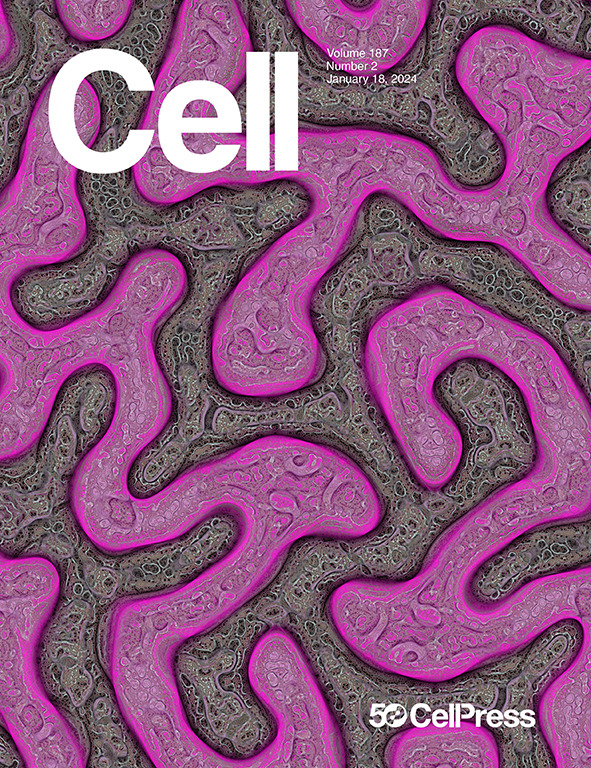小型和长型非编码 RNA:过去、现在和未来
IF 45.5
1区 生物学
Q1 BIOCHEMISTRY & MOLECULAR BIOLOGY
引用次数: 0
摘要
自 1958 年提出分子生物学的核心教条以来,人们发现了各种 RNA 物种。信使核糖核酸(Messenger RNA)将 DNA 的遗传指令传递给蛋白质的制造者,而这一过程则由核小核糖核酸(snRNA)、核糖体核糖核酸(rRNA)和转运核糖核酸(tRNA)等看家非编码核糖核酸(ncRNA)来完成。在过去的四十年中,一系列调控性 ncRNA 已经成为基因调控的关键角色。为庆祝《细胞》杂志创刊 50 周年,本综述探讨了我们目前对研究最广泛的调控 ncRNA--小 RNA 和长非编码 RNA(lncRNA)--的理解,它们深刻地影响了 RNA 生物学及其他领域。小 RNA 通路的机制已被清楚地记录下来,而 lncRNA 则表现出更多样化的机制,其中许多机制仍不为人所知。本综述涵盖了发现它们的关键事件、生物发生途径、进化特征、作用机制、功能以及 ncRNA 之间的交叉关系。我们还强调了它们在病理生理环境中的作用,并提出了未来的研究方向,以利用小 RNA 的经验教训来破解 lncRNA 的未知问题。本文章由计算机程序翻译,如有差异,请以英文原文为准。
Small and long non-coding RNAs: Past, present, and future
Since the introduction of the central dogma of molecular biology in 1958, various RNA species have been discovered. Messenger RNAs transmit genetic instructions from DNA to make proteins, a process facilitated by housekeeping non-coding RNAs (ncRNAs) such as small nuclear RNAs (snRNAs), ribosomal RNAs (rRNAs), and transfer RNAs (tRNAs). Over the past four decades, a wide array of regulatory ncRNAs have emerged as crucial players in gene regulation. In celebration of Cell’s 50th anniversary, this Review explores our current understanding of the most extensively studied regulatory ncRNAs—small RNAs and long non-coding RNAs (lncRNAs)—which have profoundly shaped the field of RNA biology and beyond. While small RNA pathways have been well documented with clearly defined mechanisms, lncRNAs exhibit a greater diversity of mechanisms, many of which remain unknown. This Review covers pivotal events in their discovery, biogenesis pathways, evolutionary traits, action mechanisms, functions, and crosstalks among ncRNAs. We also highlight their roles in pathophysiological contexts and propose future research directions to decipher the unknowns of lncRNAs by leveraging lessons from small RNAs.
求助全文
通过发布文献求助,成功后即可免费获取论文全文。
去求助
来源期刊

Cell
生物-生化与分子生物学
CiteScore
110.00
自引率
0.80%
发文量
396
审稿时长
2 months
期刊介绍:
Cells is an international, peer-reviewed, open access journal that focuses on cell biology, molecular biology, and biophysics. It is affiliated with several societies, including the Spanish Society for Biochemistry and Molecular Biology (SEBBM), Nordic Autophagy Society (NAS), Spanish Society of Hematology and Hemotherapy (SEHH), and Society for Regenerative Medicine (Russian Federation) (RPO).
The journal publishes research findings of significant importance in various areas of experimental biology, such as cell biology, molecular biology, neuroscience, immunology, virology, microbiology, cancer, human genetics, systems biology, signaling, and disease mechanisms and therapeutics. The primary criterion for considering papers is whether the results contribute to significant conceptual advances or raise thought-provoking questions and hypotheses related to interesting and important biological inquiries.
In addition to primary research articles presented in four formats, Cells also features review and opinion articles in its "leading edge" section, discussing recent research advancements and topics of interest to its wide readership.
 求助内容:
求助内容: 应助结果提醒方式:
应助结果提醒方式:


